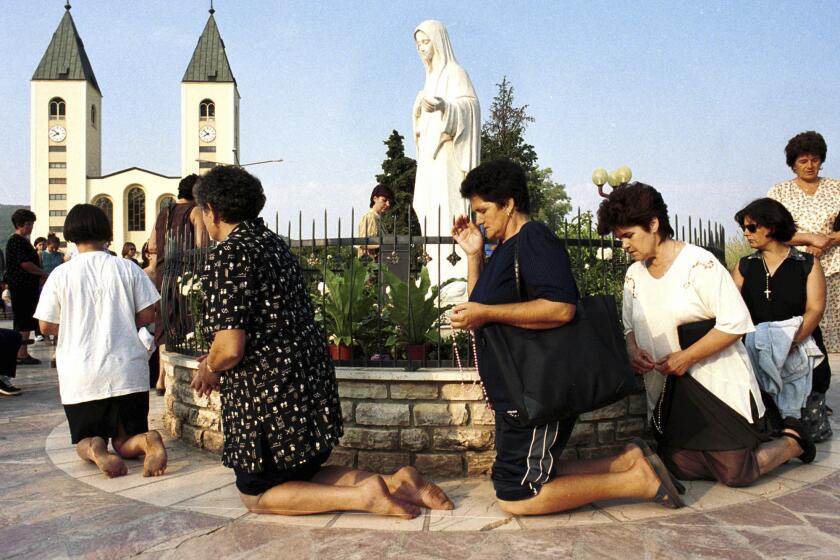Teamwork Is Bringing the White Seabass Back
The happy screams of wading children filled the air as the little fish brushed their feet and legs en route to what is hoped will be a long and productive life at sea.
For the adults on the beach at Two Harbors on Santa Catalina Island, the ceremonial release of 50 juvenile white seabass last weekend was of far greater significance. The island’s grow-out facility, one of 14 in Southern California, had become the first to turn loose 100,000 hatchery-born seabass.
An embattled fishery, involving a species immensely popular among anglers, is rebounding in large part because of their efforts.
The fishing tournament after the ceremony “highlights the success of the white seabass fishery, and of the white seabass release program,” said Tom Raftican, president of United Anglers of Southern California, an advocacy group with nearly 10,000 members.
The tournament also provided an opportunity for scientists to scan fish heads for tiny coded tags that reveal vital information about fish born as part of the Ocean Resources Enhancement and Hatchery Program.
“It’s a celebration of cooperation,” said Don Kent, president of the Hubbs-Sea World Research Institute, which is spearheading the effort. “It’s about everyone working together instead of getting sued into doing something. There’s such a rhetoric out there now, with people saying, ‘Well, if you don’t do it, we’ll sue you over it.’ With this program it’s all about, ‘Hey, how about if we get this thing done together?’ ”
The 20-year-old program is funded largely by the sale of a $3.95 stamp affixed to saltwater fishing licenses. The fish are spawned and tagged in a Carlsbad hatchery and delivered to grow-out pens maintained by volunteers in Southland harbors. They’re raised to 8-12 inches and set free, thousands at a time.
“My personal goal is for my kids to be able to catch white seabass,” said Doug Oudin, the local harbormaster, a program volunteer and avid angler. “More immediately, to try to restore the population so that the recreational anglers have the opportunity to catch these fish, which are so magnificent.”
Releases were modest early on, but for the last five years, they’ve exceeded 100,000 fish annually. Specimens from the first substantial release in 2001 should now be of legal size, 28 inches, so scientists urge anglers to deposit heads at the nearest sportfishing landing.
Though the sportfishing season is young and the commercial season has yet to begin, nine tags have already been recovered this year, including one from a fish caught at Santa Rosa Island nearly 12 years after being released off Ventura.
Scientists have determined that hatchery-born seabass mix and spawn with wild stocks, and travel farther than previously believed. A fish released off Santa Barbara was caught at Cortes Bank, 100 miles off Orange County. Tagged fish released at Catalina were caught off the mainland and vice versa. In one case, two fish released off Santa Barbara in 1994 were caught on the same day 10 years later off Ventura.
“We know it works; it’s just how well it works that we’re trying to refine,” Kent said of the effort. “But we know the fish survive and know that they contribute to the population.”
White seabass, broad-tailed croakers that can measure five feet and weigh up to 80 pounds, are prized for their tender white flesh and spirited fight. There are tales of island waters turning black with roiling fish in the 1930s and ‘40s. But widespread use of gill nets by commercial fishermen took a heavy toll.
Sportfishing boat landings were 65,545 in 1949 but had dipped to about 1,000 fish annually by the late 1980s. The hatchery enhancement project was born of this situation, and an outcry in the angling community helped bring about the voter-approved Marine Resources Protection Act of 1990, which banned gill nets within three miles of the coast and one mile from the Channel Islands.
A gradual recovery has been apparent during the last several seasons, including this one, as thousands of white seabass have already been caught by anglers limited to one fish a day.
However, the bite shut down in the Catalina tournament, in which the 46-pound winning fish was one of only a few specimens coming ashore, none with tags.
But that’s the nature of seabass fishing -- they tend to bite as one or not at all -- and the fishermen could at least take solace that there’s always next year. And the year after that, and so on.
Said Raftican, “Even when catches drop off right now, we’re still head and shoulders above what it used to be like.”
More to Read
Start your day right
Sign up for Essential California for news, features and recommendations from the L.A. Times and beyond in your inbox six days a week.
You may occasionally receive promotional content from the Los Angeles Times.






